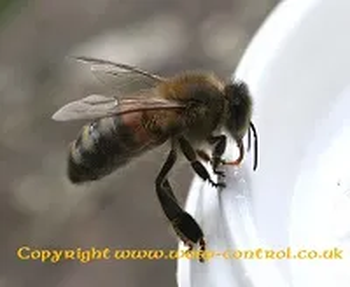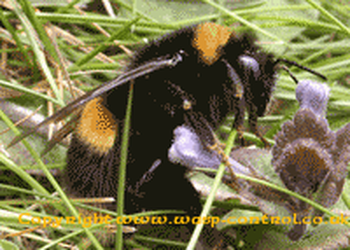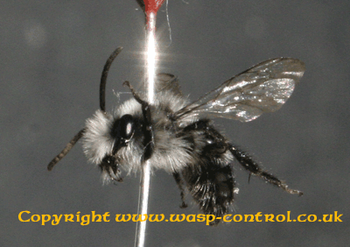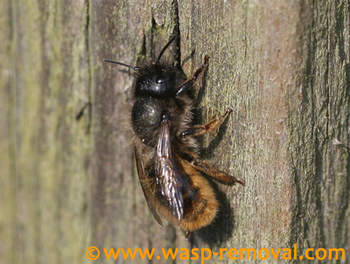Bee Identification
How To Identify The Most Common Bee Species
Honey Bee
The UK is home to various bee species, but we'll focus on the ones you're likely to encounter. To distinguish between wasps and bees, note that wasps are smooth and bald, while bees are furry. Check out the bee photos for a visual comparison.
Honey bees, though similar in size to wasps, are generally darker and have a fluffy thorax. Colonies vary in size, ranging from a couple of thousand in small colonies to 50,000 in large ones.
It's important to differentiate between a wild honey bee nest and a beehive. A beehive is a man-made structure (usually wood) housing a honey bee nest, manipulated by beekeepers for easier management. Wild honey bee nests operate naturally, managed by the bees themselves.
Honey bees collect pollen visible on their hind legs and gather nectar, which they convert into honey. They store a surplus for winter. The colony's temperament is influenced by genetics, and honey bees, due to their numbers, can be more hazardous than wasps.
If you encounter a honey bee swarm, check our honey bee swarm collectors page for local assistance. For established honey bee colonies within your property, explore our bee removal page for possible solutions.

Bumble Bee
Bumblebees are easily recognizable with their black, round bodies and notably fluffy appearance. Various species of bumblebees exist, differing in size. Colonies are relatively small, typically ranging from 50 to 100 individuals.
These bees primarily collect pollen to feed their young and produce modest amounts of honey for their own sustenance throughout the summer. The three most common bumblebee species include:
- Whitetail bumblebee (Bombus lucorum): Recognizable by their large size and white posterior. Known for their calm nature, they only sting in self-defense.
- Garden bumblebee (Bombus hortorum): Resembling the whitetail bumblebee in appearance.
- Tree bumblebee (Bombus hypnorum): Smaller than the whitetail bumblebee, relatively new to the UK. Known for their boldness and aggressive defense of nests, often preferring higher nesting locations like roofs and bird boxes.
While bumble bees can sting if provoked, they are generally well-natured and will peacefully go about their activities if left undisturbed.
If you find a bumblebee nest in a challenging location, some pest controllers and beekeepers may be willing to remove and relocate them for a small fee. Reach out to your local pest controller for further guidance.

Harmless Bee Species.
Encountered frequently are Mining Bees and Mason Bees, both of which are harmless and lack the ability to sting people with any significant impact. While they possess a stinger, it is not strong enough to penetrate human skin.
Mining and Masonry bees are solitary creatures, living independently except during mating, when they may gather in relatively small numbers, usually less than 100 individuals. It's advisable not to destroy either species.
Mining Bees create burrows in the ground for egg-laying, resembling wormholes with a soil mound at the tunnel's entrance. Active in spring, they only stay for a brief period, disappearing once their eggs are laid.
Mason Bees, sometimes mistaken for wasps in spring, burrow into soft mortar in brickwork or use the plastic mortar vents in modern houses. They fill these openings with mud and pollen to lay eggs, remaining active for about a month in spring before disappearing. If Masonry Bees are burrowing into your brickwork, it's recommended to have the brickwork re-pointed.
Grey Mining Bee

Mason Bee

Are Bees a Cause for Concern?
The question of whether bees pose a threat can be distilled into a straightforward answer: Bees with the ability to sting can indeed be dangerous, particularly for individuals with allergies or those subjected to multiple stings.
Among the stinging varieties, two prominent species stand out: Honey Bees and Bumble Bees.
Honey Bees, in particular, can present a significant danger, primarily due to the sheer number of individuals within a colony. The potential risk is amplified by the fact that each bee within the colony is equipped with a stinger.
Tragically, there are instances each year where individuals, often beekeepers, succumb to fatal encounters with Honey Bees. While bees kept in hives are generally known for their amiable disposition, there are occasions when, for various reasons, they become highly aggressive. During such episodes, they may launch attacks on anything that encroaches upon their nest or hive.
It is worth noting that although bee-related fatalities are relatively rare, a heightened awareness of the potential dangers associated with bee stings is crucial. For those with allergies or anyone at risk of multiple stings, taking precautions and being mindful of bee behavior becomes paramount in ensuring personal safety.


